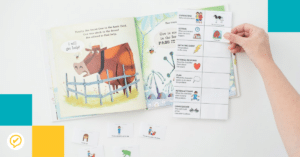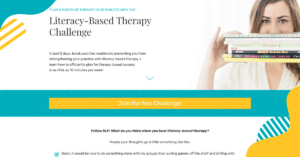This is a guest blog post by Monica, a school-based SLP, on how to streamline your speech and language evaluations by using the PICO question as an evidence-based strategy.
We’ve all faced the same problem of wanting to get a lot done with our evaluations, but not having enough hours in the day. There are so many things to accomplish with an evaluation: addressing teacher and parent concerns, seeing where the student is developmentally, finding patterns of strengths, finding areas of needs, planning for new goals, thinking about what EBP interventions we’re going to use with the student, and considering influences like other languages and cultures (at the very least!). I think especially when we have a lot of evaluations going on at the same time, posing each evaluation as a PICO question could help to hone in on what you want to get out of the evaluation. I also tend to get stuck in a rut of doing the same type of evaluations, especially when there is a lot to juggle with my workload. I like to think of my end game first and then form a plan from there.
Here is how to break down the PICO question according to ASHA.
P – Population/Problem, “What are the characteristics and/or condition of the group? This may include specific diagnoses, ages, or severity levels (e.g., autism spectrum disorder, mild hearing loss).”
I – Intervention/Indication, “What is the screening, assessment, treatment, or service delivery model that you are considering”
C – Comparison/Control, “What is the main alternative to the intervention, assessment, or screening approach (e.g., placebo, different technique, different amount of treatment)? Note: In some situations, you may not have a specific comparison in your PICO question.”
O – Outcome, “What do you want to accomplish, measure, or improve (e.g., upgraded diet level, more intelligible speech, better hearing in background noise)?”
PICO Question Example
For example, we have a kindergarten student with suspected autism. The student’s parent is going to seek an evaluation referral from their primary care physician, and the school team is going to start an evaluation. The teacher has concerns about social skills and language.
When I think about what to fill out first, usually I’ll think about the population first. BUT, I will often think about what type of intervention I know to be evidence-based practice for that population and what information I will need to drive goals. For the autistic population, I know that I’ll need a good picture of how they are functioning in real life, not just what a standardized test can give me, and that I’ll need to do extensive interviewing with the teacher and caregivers. One type of intervention I will most likely want to use is to work on them having a foundation of perspective-taking skills to improve their comprehension and ability to interact with peers in a way that is comfortable for them. We often come across the problem of not being able to identify strengths with formalized assessment, so we’ll explore other ways to gain information.
Start with the (O)utcome in the PICO question
To get a whole picture of the child/student. What their strengths and needs are, with a focus on perspective-taking and comprehension.
P – Student in kindergarten, areas of concern: language, social skills (suspected autism)
I –
C –
O – To get a whole picture of the child/student. What their strengths and needs are, with a focus on perspective-taking and comprehension.
Next (I)ntervention and (C)omparison
We typically have formal and informal assessments, so let’s compare the results of those two, and see what we would miss if we only did formal/standardized testing. The same PICO method could be used to think about which standardized tests to give, what would you be missing, or what to consider when deciding which test to administer. (Other things to consider are the norming population, the complexity of language used in the test, and if the test is really testing for what you are looking for).
What ways could you fill the gap left by formal testing?
P – Student in kindergarten, areas of concern: language, social skills (suspected autism)
I – Formal and informal testing in all areas of concern
C – Only formal/standardized testing
O – To get a whole picture of the child/student. What their strengths and needs are, with a focus on perspective-taking and comprehension.
Informal Testing Tips
Use informal testing as a way to fill the gaps with formal standardized testing. In this case, I would do extensive interviews with the teacher/school staff/caregivers and observations. Narratives are an important area of intervention for the autistic population because it can target both language and perspective-taking skills (Gilliam, Hartzheim, Studenka, Simonsmeier, Gilliam, 2015). I usually start with informal assessments to build rapport, and it is often the most useful data. Next, I finish up with some quick informal assessment after formal standardized assessment if there was an identified area of need. Hadley & Dickinson (2018), showed that a language sample during storytelling is a better indicator of a child’s vocabulary skills. With the language sample, you could ask the child to describe their favorite foods or movie and get baseline data in describing.
An informal retell of a wordless picture book could give you information on perspective-taking skills and if they picked up on any emotions in the story.
Asking questions during and/or after the story could give you information on their comprehension skills, as well as classwork samples and teacher interview.
You could also use this time to assess overall intelligibility (and figure out what kind of speech sound disorder assessment you want to do if that’s an area of need).
Use Visuals
Because it’s informal testing, you’re able to use any visuals and prompting you might need, which is also a great indicator of what type of supports the child might need in the classroom and with your intervention. I use my favorite materials during this portion of the informal assessment, and can get a lot of information that I might have missed with just a standardized assessment. Visuals like this Describing Helper makes your SLP life easier. This is also a great time to test out some speech sound interventions and different levels of prompting. (Were you able to get a sound with a quick phonological awareness task? Or with some very specific motor-based prompts?)
Check in with the teacher or caregiver.
Do a quick check back with the parents and teachers to make sure what I’m seeing in the assessment sounds like their child and I’m set. We can now see that the (C)omparison: only using formal/standardized testing would have missed a lot of valuable information. Starting with identifying what strengths to build on, and what interventions might be appropriate, has really streamlined my assessments. This also helps when I have a complex case and it feels overwhelming to start. It’s cut down on the time I need to take to sit down and write goals and get baseline data because it’s an all-in-one process.
Here’s a quick summary of the process:
1. Make a PICO question.
2. Get a language sample and check in with teachers and caregivers.
3. Do standardized/formal assessments.
4. Do follow-up informal assessments: embed getting baseline data and prompting.
5. Do a quick trial of interventions that may work with the strengths of the student.
6. Write goals and form a treatment plan from your data.
7. Check back in with teachers and caregivers, if needed.
Looking for more resources to test a student with a culturally diverse background? Dynamic assessment is also another informal measure that will give a better indicator of their skills. The Leader’s Project has a great explanation of the test-teach-retest model of dynamic assessment here.
References
American Speech-Language-Hearing Association. (n.d.). EBP Process – Step 1: Frame Your Clinical Question. https://www.asha.org/research/ebp/frame-your-clinical-question/
Gillam, S. L., Hartzheim, D., Studenka, B., Simonsmeier, V., & Gillam, R. (2015). Narrative Intervention for Children With Autism Spectrum Disorder (ASD). Journal of Speech, Language, and Hearing Research, 58(3), 920–933.
Hadley, E. B., & Dickinson, D. K. (2020). Measuring young children’s word knowledge: A conceptual review. Journal of Early Childhood Literacy, 20(2), 223–251.






Leave a Reply